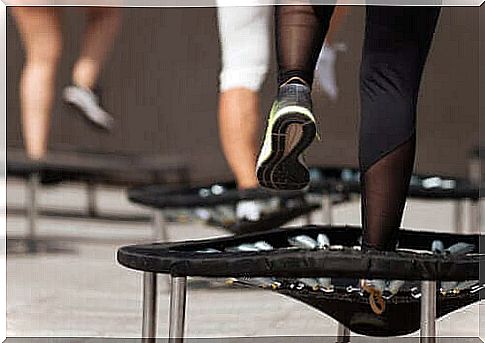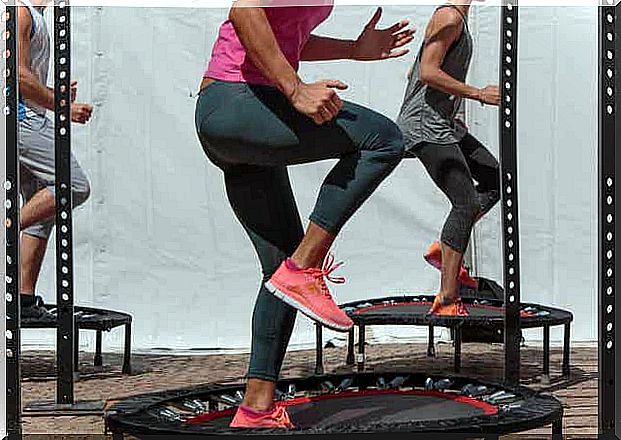Jumping Fitness: How Can You Do It?

Jumping Fitness, or body jumping, is a discipline that originated in 2001 in the Czech Republic. Instructors Jana Svodova and Tomas Burianek combined the principles of aerobics with a trampoline to minimize impact on the joints and make classes more dynamic.
Sessions last 45 to 60 minutes, with music to accompany the exercises and with variations in the intensity of the movements. Therefore, it is related to other forms of training such as:
- body pump
- body balance
- fit boxing
- pilates
- spinning
This training form differs from all others because jumping fitness is done on a trampoline. In recent years there has been an increasing interest from gyms and sports enthusiasts.
Today you can find classes in more than 30 countries and they are emerging as an alternative to conventional aerobic exercise. That’s why we’re going to show you how to do jumping fitness and some of its benefits.
What are the benefits of jumping fitness?

The main reason to do jumping fitness is to relieve the joints. Some aerobic disciplines have a major impact on the knees, ankles and hips. This can eventually lead to wear, pain, inflammation and injury.
Fortunately, the trampoline on which you do the exercises helps to significantly relieve stress in these areas, as it acts as a cushion of sorts for every movement. You perform a multitude of aerobic exercises on the trampoline, which offer benefits such as:
- Reducing episodes of depression: all forms of physical activity are positive for psychological well-being. However, this evidence indicates that aerobic disciplines can be extra good in this case.
- It helps to control weight: In combination with a balanced diet, jumping fitness can help you maintain your weight or lose weight. Jumping fitness combines different intensities of aerobic movements, which according to studies is beneficial for weight loss.
- It keeps cholesterol and triglyceride levels in check: Studies have confirmed that performing moderate and high-intensity physical activity helps to control cholesterol and triglycerides.
- Lowering blood pressure: 45 to 60 minutes of activity on the trampoline helps to lower blood pressure. It is ideal for people suffering from hypertension or as a preventive method. Several studies have shown this. In any case, a preliminary evaluation by a cardiologist is advisable before starting these workouts.
- It contributes to executive functioning: this is the improvement of cognitive capacity, attention, memory and concentration. This is what the evidence suggests, so it’s one of the reasons aerobic activity is recommended for older adults.
- It’s a cardioprotective activity: especially if you do it at a high intensity, although moderate-intensity aerobic exercise has also been shown to have positive effects on the heart.
How do you perform jumping fitness?
As we mentioned, jumping fitness includes lessons of 45 to 60 minutes. Sometimes you can find 30 minute sessions for those new to jumping fitness.
A trainer who is also responsible for selecting the accompaniment music will lead the session. In theory, this music helps to guide the movements and set the pace to go from medium to high intensity.
The trainer selects the moves based on the level of the participants, the purpose of the lesson and the trainer’s experience. All of this takes place on a trampoline that may or may not have a supporting handle. Below we will show how an average lesson is structured.
1. Warm up
As with any other discipline, jumping fitness starts with warming up and stretching the muscles. While it’s possible to do both off the trampoline, the goal of the first 5 minutes of a typical class is to prep your muscles once you’re on the trampoline. The trainer will therefore use the following as a warm-up routine with the help of the music:
- Jump gently with legs fully extended.
- Jump gently with claps and knee lifts.
- Jumps with a 90 degree turn and return to the starting position.
- Scissor or T-jumps.
- Jumps from left to right.
- Jump like you do with skipping rope.
These are some of the warm-up moves that are essential to avoid injury and achieve maximum muscle performance. No training session should begin without a proper warm-up.
2. Jogging
It is possible to adapt the jogging to a trampoline, so every session of jumping fitness includes this form of movement for a few minutes. It is less taxing on the joints and safer to do for certain groups of people.
In general, the intensity is moderate, although there may be times when it rises to a high peak. It requires more stability in the muscles of your torso and calves and the quadriceps, because the small changes resulting from the rebounding effect of the trampoline cause the center of gravity to become unbalanced with every step.
3. Aerobics on the trampoline

Aerobics is one of the most underrated forms of exercise. One high-intensity session can burn up to 500 calories, so all jumping fitness classes include some form of dancing. The exercises are chosen depending on the participants. They can therefore range from Zumba to belly dancing.
For greater comfort, large trampolines can be used, increasing the base area for greater freedom of movement. In order to try to achieve a higher calorie consumption, it is very common for the trainer to make changes in the jumps and improvise more.
4. Weight Exercises
Although weights are not used in all sessions, it is possible during a jumping fitness session. In this case, aerobic and anaerobic activities are combined in a single routine and muscle strengthening is also achieved. Naturally, the weight is limited to just a few kilograms in order to preserve the essence of the discipline and avoid accidents with the trampoline.
Most moves can be adapted to use the weights, although classic anaerobic exercises can also be done with the addition of jumping. It all depends on your fitness and goals.
Considerations if you want to do jumping fitness at home
These were a few examples of what a jumping fitness class looks like. Nothing prevents you from doing it at home, although you should consider a few details beforehand:
- Make sure you choose a trampoline that can support your weight.
- Clear the space to avoid bumping when extending your legs and arms.
- Make sure the contact points are firmly on the ground. If the trampoline does not have these, consider adding non-slip rubbers.
- Wear sports clothing in which you can move freely.
- Wear good athletic shoes for better stability. After you gain more experience, you can try barefoot classes.
- And finally, don’t continue a session if you feel pressure in your chest, excessive discomfort in the pelvic area, or muscle pain.
In addition to all this, you should also know that there are some contexts where jumping fitness has contraindications. These include situations where there is urinary incontinence, dizziness, ankle sprains or recent joint injuries. It is also not recommended after 5 months of pregnancy. However, you can consult a medical specialist if you have any questions.
Finally, remember that you need an average of 5 or 6 lessons to familiarize yourself with the movements and balance on the trampoline. Therefore, it is best to avoid exceeding possibilities to avoid injury or delay.









